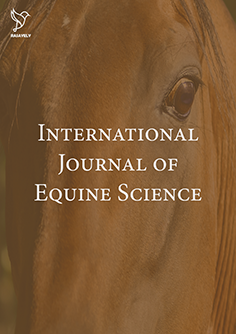Case Series Presenting a Modified Approach for Permanent Perineal Urethrostomy in Horses
Modified Approach for Uresthrostomy in Horses
Keywords:
Inverted triangle incision, Gelding, urine staining, urethral trauma, urinary system, Williams techniqueAbstract
Permanent perineal urethrostomy (PPU) may be performed in horses with severe preputial or penile trauma, in which surgical repair of extensive urethral damage is too complex or even impossible. We hypothesized that a modified PPU approach would abolish the use of postoperative indwelling urinary catheters (PIUC) and that the complication rate would be low. Therefore, the main objective of this report is to share our experience performing a modified approach for PPU in horses. Four geldings were referred after a history of severe urogenital laceration, and PPU was performed by removing a skin flap incision forming an inverted triangle (2.5 cm base and 5 cm sides) on the perineal raphe. None of the horses were submitted to the placement of PIUC. Short-term complications were restricted to partial PPU wound dehiscence in one horse, but this did not impede complete healing. Complications encountered after hospital discharge comprised urine staining of the hind legs in two (50%) horses. Urethral stoma retraction was a common sequel in all horses, but it did not impair urinary patency. The main limitations of this study were the small sample size and reliance on owner recall for outcome information. Overall, the complication rate was considered low, and owner satisfaction with the post-operative result was high. In conclusion, the modified approach for PPU using the inverted triangle-shaped incision adapted from the Williams technique of partial phallectomy proved to be a suitable alternative in the described horses, abolishing the use of PIUC. Furthermore, the urethral stoma remained patent in all horses even 75 months after surgery.
References
Schott II HC, Woodie JB. Urethra. In: Auer JA, Stick JA, Kummerle JN, Prange T, editors. Equine Surgery. 5th ed, St. Louis: Elsevier; 2019, p. 1145–55.
Barbosa LAL, Silva VAN, Lima JG, Duarte MD, de Oliveira Monteiro FD, Bezerra Junior PS, et al. Surgical treatment of exuberant granulation tissue of the glans penis and paraphimosis in a stallion. Equine Vet Educ 2023;35:e268–72. https://doi.org/10.1111/eve.13697.
Schumacher J, Varner DD. Surgical correction of abnormalities affecting the reproductive organs of stallions. In: Youngquist RS, Threlfall WR, editors. Current Therapy in Large Animal Theriogenology. 1st ed, St. Louis: Elsevier; 2007, p. 23–36.
Maurer T, Brünisholz HP, O'Brien T, Coleridge M, Klopfenstein-Bregger MD, Koch C. Complications, outcome and owner satisfaction after Callicrate Bander phallectomy and perineal urethrostomy in 14 equids. Equine Vet Educ 2022;34:e570–80. https://doi.org/10.1111/eve.13615.
Sanclemente JL, Ragle CA, Lund CM. Midbody penile urethrocutaneous fistula repaired by fistulectomy and urethral anastomosis in a stallion. J Am Vet Med Assoc 2021;258:1007–10. https://doi.org/10.2460/javma.258.9.1007.
Campebell R de C, Silva FB da, Silva JFB, Rehbein L da S, Argenta VL de S, Ribeiro E, et al. Obstructive urethrolithiasis in a mule. Acta Sci Vet 2021;49:674. https://doi.org/10.22456/1679-9216.111984.
Rowe EL, White NA. Diagnosis of gastrointestinal disease. In: White NA, Moore JN, Mair TS, editors. The Equine Acute Abdomen. 2nd ed, Jackson, WY: Teton Newmedia; 2008, p. 236–87.
Freeman KP, Farr AJ, Barrelet A. Hematology of equids. In: Brooks MB, Harr KF, Seelig DM, Wardrop KJ, Weiss DW, editors. Schalm's Veterinary Hematology. 7th ed, Hoboken: John Wiley & Sons; 2022, p. 993–1003.
Kaneko JJ, Harvey JW, Bruss ML. Clinical biochemistry of domestic animals. 6th ed. San Diego: Academic Press; 2008.
Presland SL, Morgan ER, Coles GC. Counting nematode eggs in equine faecal samples. Vet Rec 2005;156:208–10. https://doi.org/10.1136/vr.156.7.208.
Kilcoyne I, Dechant JE. Complications associated with perineal urethrotomy in 27 equids. Vet Surg 2014;43:691–6. https://doi.org/10.1111/j.1532-950X.2014.12169.x.
Straticò P, Varasano V, Celani G, Suriano R, Petrizzi L. Long-term outcome of en bloc extensive resection of the penis and prepuce associated with a permanent perineal urethrostomy in a gelding affected by squamous cell carcinoma. Case Rep Vet Med 2016;2016:6989450. https://doi.org/10.1155/2016/6989450.
Wylie CE, Payne RJ. A modified surgical technique for penile amputation and preputial ablation in the horse. Equine Vet Educ 2016;28:269–75. https://doi.org/10.1111/eve.12363.
Williams WL. The Diseases of the Genital Organs of Domestic Animals. 3rd ed. Worcester: Ethel Williams Plimpton; 1943.
Arnold CE, Brinsko SP, Love CC, Varner DD. Use of a modified Vinsot technique for partial phallectomy in 11 standing horses. J Am Vet Med Assoc 2010;237:82–6. https://doi.org/10.2460/javma.237.1.82.
Downloads
Published
Issue
Section
License
Copyright (c) 2023 Antônio C.L. Câmara, Haiane A.L. Amorim, Fabio H.B. Ximenes, Rita C. Campebell

This work is licensed under a Creative Commons Attribution 4.0 International License.
Authors retain the copyright of their manuscripts, and all Open Access articles are distributed under the terms of the Creative Commons Attribution License, which permits unrestricted use, distribution, and reproduction in any medium, provided that the original work is properly cited.

